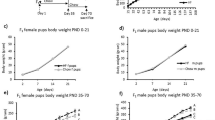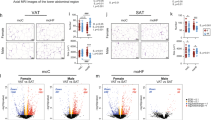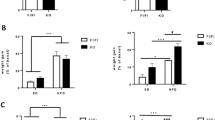Abstract
Background:
The obesity epidemic, recognized in developed nations for decades, is now a worldwide phenomenon. All age groups are affected, including women of childbearing age, fueling concern that maternal obesity before and during pregnancy and lactation impairs developmental establishment of body weight regulatory mechanisms in the fetus or infant, causing transgenerational amplification of obesity prevalence and severity. The biological mechanisms underlying such processes remain unknown.
Methods:
We used agouti viable yellow (Avy) mice to test the hypothesis that maternal obesity induces transgenerational amplification of obesity. We passed the Avy allele through three generations of Avy/a females and assessed cumulative effects on coat color and body weight. By studying two separate but contemporaneous populations of mice, one provided a standard diet and the other a methyl-supplemented diet that induces DNA hypermethylation during development, we tested whether potential transgenerational effects on body weight might be mediated by alterations in epigenetic mechanisms including DNA methylation.
Results:
The genetic tendency for obesity in Avy mice was progressively exacerbated when the Avy allele was passed through successive generations of obese Avy females. This transgenerational amplification of body weight was prevented by a promethylation dietary supplement. Importantly, the effect of methyl supplementation on body weight was independent of epigenetic changes at the Avy locus, indicating this model may have direct relevance to human transgenerational obesity.
Conclusion:
Our results show that in a population with a genetic tendency for obesity, effects of maternal obesity accumulate over successive generations to shift the population distribution toward increased adult body weight, and suggest that epigenetic mechanisms are involved in this process.
This is a preview of subscription content, access via your institution
Access options
Subscribe to this journal
Receive 12 print issues and online access
$259.00 per year
only $21.58 per issue
Buy this article
- Purchase on SpringerLink
- Instant access to full article PDF
Prices may be subject to local taxes which are calculated during checkout




Similar content being viewed by others
References
Lawlor DA, Smith GD, O'Callaghan M, Alati R, Mamun AA, Williams GM et al. Epidemiologic evidence for the fetal overnutrition hypothesis: findings from the mater-university study of pregnancy and its outcomes. Am J Epidemiol 2007; 165: 418–424.
Levin BE . The obesity epidemic: metabolic imprinting on genetically susceptible neural circuits. Obes Res 2000; 8: 342–347.
Darnton-Hill I, Nishida C, James WP . A life course approach to diet, nutrition and the prevention of chronic diseases. Public Health Nutr 2004; 7: 101–121.
Keith SW, Redden DT, Katzmarzyk PT, Boggiano MM, Hanlon EC, Benca RM et al. Putative contributors to the secular increase in obesity: exploring the roads less traveled. Int J Obes (Lond) 2006; 30: 1585–1594.
Kral JG, Biron S, Simard S, Hould FS, Lebel S, Marceau S et al. Large maternal weight loss from obesity surgery prevents transmission of obesity to children who were followed for 2 to 18 years. Pediatrics 2006; 118: e1644–e1649.
Villamor E, Cnattingius S . Interpregnancy weight change and risk of adverse pregnancy outcomes: a population-based study. Lancet 2006; 368: 1164–1170.
Guo F, Jen KL . High-fat feeding during pregnancy and lactation affects offspring metabolism in rats. Physiol Behav 1995; 57: 681–686.
Wu Q, Suzuki M . Parental obesity and overweight affect the body-fat accumulation in the offspring: the possible effect of a high-fat diet through epigenetic inheritance. Obes Rev 2006; 7: 201–208.
Chehab FF, Lim ME, Lu R . Correction of the sterility defect in homozygous obese female mice by treatment with the human recombinant leptin. Nat Genet 1996; 12: 318–320.
Bates SH, Stearns WH, Dundon TA, Schubert M, Tso AW, Wang Y et al. STAT3 signalling is required for leptin regulation of energy balance but not reproduction. Nature 2003; 421: 856–859.
Chen Y, Duhl DM, Barsh GS . Opposite orientations of an inverted duplication and allelic variation at the mouse agouti locus. Genetics 1996; 144: 265–277.
Morgan HD, Sutherland HG, Martin DI, Whitelaw E . Epigenetic inheritance at the agouti locus in the mouse (see comments). Nat Genet 1999; 23: 314–318.
Yen TT, Gill AM, Frigeri LG, Barsh GS, Wolff GL . Obesity, diabetes, and neoplasia in yellow A(vy)/- mice: ectopic expression of the agouti gene. FASEB J 1994; 8: 479–488.
Bjorntorp P . Thrifty genes and human obesity. Are we chasing ghosts? Lancet 2001; 358: 1006–1008.
Waterland RA, Travisano M, Tahiliani KG . Diet-induced hypermethylation at agouti viable yellow is not inherited transgenerationally through the female. FASEB J 2007; 21: 3380–3385.
Wolff GL, Kodell RL, Moore SR, Cooney CA . Maternal epigenetics and methyl supplements affect agouti gene expression in Avy/a mice. FASEB J 1998; 12: 949–957.
Waterland RA, Jirtle RL . Transposable elements: targets for early nutritional effects on epigenetic gene regulation. Mol Cell Biol 2003; 23: 5293–5300.
Vadlamudi S, Kalhan SC, Patel MS . Persistence of metabolic consequences in the progeny of rats fed a HC formula in their early postnatal life. Am J Physiol 1995; 269: E731–E738.
Levin BE, Govek E . Gestational obesity accentuates obesity in obesity-prone progeny. Am J Physiol 1998; 275: R1374–R1379.
Dolinoy DC, Weidman JR, Waterland RA, Jirtle RL . Maternal genistein alters coat color and protects Avy mouse offspring from obesity by modifying the fetal epigenome. Environ Health Perspect 2006; 114: 567–572.
Wolff GL . Body composition and coat color correlation in different phenotypes of ‘Viable Yellow’ mice. Science 1965; 147: 1145–1147.
Holliday R . The inheritance of epigenetic defects. Science 1987; 238: 163–170.
Jones PA, Baylin SB . The fundamental role of epigenetic events in cancer. Nat Rev Genet 2002; 3: 415–428.
Rankinen T, Zuberi A, Chagnon YC, Weisnagel SJ, Argyropoulos G, Walts B et al. The human obesity gene map: the 2005 update. Obesity (Silver Spring) 2006; 14: 529–644.
Waterland RA . Does nutrition during infancy and early childhood contribute to later obesity via metabolic imprinting of epigenetic gene regulatory mechanisms? In: Hernell OSJ (ed). Feeding During Late Infancy and Early Childhood: Impact on Health. Nestec Ltd.: Vevey, 2005, pp 157–174.
Acknowledgements
We thank Vincent Dion, Hannah Landecker and Lanlan Shen for comments on the manuscript, and Adam Gillum for help with the figures. This study was supported by the NIH Grant 5K01DK070007, research Grant no. 5-FY05-47 from the March of Dimes Birth Defects Foundation, and USDA CRIS no. 6250-51000-049 (RAW) and NSF DEB-021306 and NSF DEB-0445351 (MT).
Author information
Authors and Affiliations
Corresponding author
Rights and permissions
About this article
Cite this article
Waterland, R., Travisano, M., Tahiliani, K. et al. Methyl donor supplementation prevents transgenerational amplification of obesity. Int J Obes 32, 1373–1379 (2008). https://doi.org/10.1038/ijo.2008.100
Received:
Revised:
Accepted:
Published:
Issue Date:
DOI: https://doi.org/10.1038/ijo.2008.100



